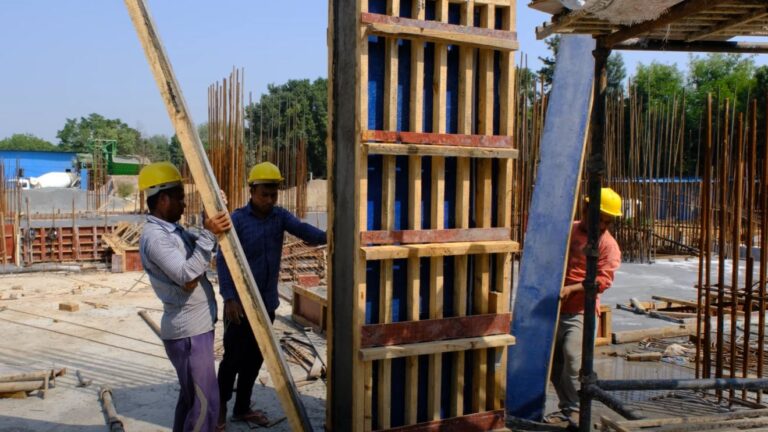Formwork is a crucial component in the construction world, providing essential support to shape and hold concrete structures as they are set. Whether constructing a high-rise building or a simple concrete wall, understanding the different types of formwork is crucial in achieving structural integrity and efficiency.
Here, we’ll explore five primary types of formwork, each with its benefits, challenges, and ideal applications.
Types of Formwork in Construction:
1. Timber Formwork
Timber formwork, one of the oldest types of formwork, remains widely used in construction projects worldwide. Made from wood or plywood, this formwork type is easy to assemble, dismantle, and adjust, making it especially suitable for small, custom projects. It’s versatile and can be shaped to fit intricate designs or layouts. However, timber formwork is less durable than other types and can degrade over time, especially when exposed to moisture or extreme weather conditions.
Advantages: Lightweight, versatile, and easy to work with on-site. Ideal for projects that require flexibility.
Disadvantages: Less durable and requires regular maintenance. Over time, timber formwork can splinter or swell.
Applications: Typically used in residential buildings or projects with unique architectural designs.
2. Steel Formwork
Steel formwork is highly durable and reusable, making it a popular choice for large-scale construction projects. Made from panels or steel plates, it provides a smooth finish on concrete surfaces, reducing the need for additional plastering. Steel formwork is also resistant to moisture and weather, making it a reliable option for long-term projects.
Advantages: It is extremely durable, can be reused multiple times, and provides a high-quality finish. It is ideal for repetitive tasks.
Disadvantages: Heavier and more expensive than timber formwork can increase transportation and handling costs.
Applications: Often used in high-rise buildings, bridges, and tunnels due to its durability and precision.
Steel formwork is an excellent example of a material that offers longevity and is resistant to environmental elements, unlike traditional types of formwork like timber.
3. Aluminium Formwork
Aluminium formwork shares many qualities with steel formwork but is significantly lighter. This makes transporting and handling on-site easier, especially when constructing large structures. The lightweight nature of aluminium formwork also means it’s faster to install and dismantle, saving valuable time on construction projects. Additionally, aluminium is corrosion-resistant, which helps improve its lifespan and reusability.
Advantages: Lightweight, corrosion-resistant, and easy to handle. Provides a smooth finish on concrete.
Disadvantages: It can be costly initially, and due to its lightweight, it may not be as stable as steel in certain high-load applications.
Applications: Widely used in residential and commercial construction, especially for structures with repetitive designs like apartment complexes.
4. Plastic Formwork
Plastic formwork is relatively new but is gaining popularity due to its lightweight properties and ease of use. Made from materials like recycled plastic, this formwork is eco-friendly and reusable, aligning with sustainable construction practices. Plastic formwork is water-resistant and ideal for wet environments or areas prone to moisture. Additionally, it’s durable and can be used multiple times, reducing overall construction waste.
Advantages: It is easy to clean, and resistant to water and chemicals, making it perfect for projects focused on sustainability.
Disadvantages: While durable, it may not be as sturdy as steel or aluminium in high-load scenarios.
Applications: Used in residential, commercial, and eco-friendly construction projects. It is particularly suitable for smaller projects and projects focused on sustainability.
Using plastic shuttering like WoWBoards, which are recycled plastic boards, contributes to a circular economy and reduces the environmental impact of construction.
5. Engineered Formwork Systems
Engineered formwork systems incorporate modular components, usually made from metal (steel or aluminium) or plastic. These systems are designed to streamline the formwork process, making assembly and disassembly quicker and easier than traditional methods. Engineered formwork systems can be reused hundreds of times, making them cost-effective and sustainable for large projects with repetitive requirements.
Advantages: Highly durable, easy to assemble, and reusable for multiple projects. Allows for rapid construction cycles.
Disadvantages: Initial costs are higher than other types of formwork, but long-term savings from reuse can offset this expense.
Applications: Widely used in large infrastructure projects like highways, dams, and high-rise buildings where repetitive formwork is required.
For projects prioritising sustainability, consider enhancing environmental benefits by using recycled plastic sheets and plastic concrete shuttering options within these engineered systems.
Why Choose the Right Type of Formwork?
Selecting suitable types of formwork in construction is critical to the success of any building project. Each type of formwork has distinct advantages and challenges, and choosing the right one depends on the project’s size, complexity, budget, and environmental goals. Construction companies can further align with green building practices, reduce waste, and support the circular economy by using sustainable materials like plastic shuttering made from recycled plastic sheets.
Plastic formwork, in particular, offers a lightweight, reusable, and eco-friendly alternative that’s increasingly suitable for various construction projects. Given the growing emphasis on eco-friendly construction, recycled plastic formwork solutions will become more prominent in the industry, helping projects meet green building standards while optimising efficiency.
Conclusion: Formwork for a Sustainable Future
With various formwork options available today, construction projects can now choose materials that align with their specific goals—achieving a unique architectural design, cutting down on costs, or embracing sustainable practices. Each type brings unique qualities, from timber and steel to modern plastic and engineered systems.
As the construction industry increasingly shifts towards environmentally responsible practices, incorporating plastic building materials like recycled plastic boards into formwork systems effectively reduces waste, enhances durability, and supports a more sustainable future. Whether working on a residential project or a commercial high-rise, selecting the appropriate formwork is essential for achieving structural integrity and environmental harmony.
Ready to explore the benefits of sustainable formwork solutions? Get in touch to learn more about how recycled plastic shuttering sheets can enhance your next project, reducing environmental impact while delivering durability and performance.

